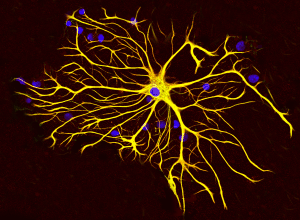“Astrocyte” – A New Migraine Term to Know?
If you’ve followed migraine research over the last few words, it’s likely that you’ve learned a lot of new lingo. Words and phrases like “photophobia”, “cortical spreading depression” and “triptan” have become surprisingly common. But do you know what an astrocyte is? (My spell checker doesn’t have a clue!)

(courtesy GerryShaw)
Let’s back up a bit. You’ve probably heard of neurons. A neuron is a special kind of cell that can conduct electrical impulses. In fact, that cortical spreading depression we just mentioned is a kind of electrical storm in the brain that sweeps through neurons, apparently leading to many of the strange auras that some migraine patients experience.
An astrocyte is another type of cell in the nervous system (the brain and the spinal cord). They get their name from their “star-shaped” form and activity. Astrocytes are extremely numerous – they outnumber neurons at least 4 to 1. But they don’t send electrical messages the way that neurons do. However, they are still very important “communicators” in the body.
Astrocytes have many complex functions in the nervous system. For example, they play an important role in the movement of blood. They play an important role on the way your body responds to viruses. (COVID-19 has the ability to infect astrocytes.) They work together with other cells to transmit pain information. It has been theorized that something “going wrong” with certain astrocyte cells may lead to symptoms of Alzheimer’s.
So what about migraine? Well, researchers were studying familial hemiplegic migraine type 2, a type of migraine characterized by a specific genetic gene mutation. They discovered that this type of migraine seems to cause a malfunction in astrocytes in the cingulate cortex, a part of the brain that processes pain. Basically, what seems to happen is that malfunctioning of astrocytes is related to the malfunction of pain – pain gets out of control.
The astrocytes help control the communication of the neurons. But what if that control isn’t working? What if your brain starts getting more “pain” signals than it should?
In mice, the researchers were able to reverse some of the effects of the genetic problem that is related to this type of migraine by manipulating astrocytes. In other words, to make it practical, we may in the future be able to develop treatments that directly influence astrocytes so that pain signals return to normal – this reducing or eliminating migraine.
Yes, this is a very early discovery related to only one type of migraine. But it’s another one of those small discoveries that could have a huge impact on future migraine treatment.
Although astrocytes may have been largely overlooked when it comes to migraine treatment, they have not gone unnoticed. For example, they were noticed as part of the link between migraine and advanced sleep phase syndrome/disorder many years ago.
And now you’re one of the first to know just a little about the complex and wonderful world of astrocytes.
For more information:
- Astrocyte dysfunction increases cortical dendritic excitability and promotes cranial pain in familial migraine (study abstract)
- Genetic malfunction of brain astrocytes triggers migraine (brief article discussing the study)
- Astrocytes: biology and pathology (detailed discussion of astrocytes, but from several years ago)
